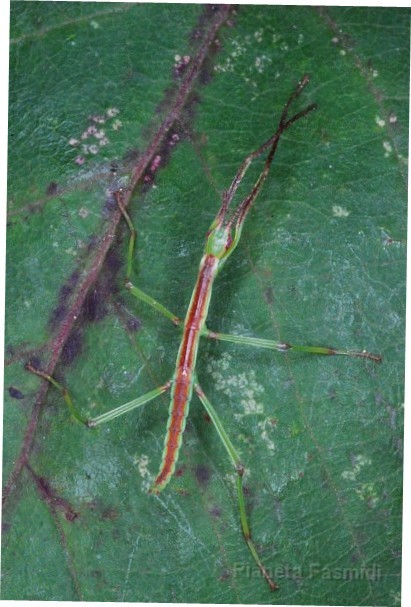Clitarchus hookeri
(Clitarchus hookeri)

Description
Clitarchus hookeri, is a stick insect of the family Phasmatidae, endemic to New Zealand. It is possibly New Zealand's most common stick insect. Clitarchus hookeri is often green in appearance, but can also be brown or red. Alongside the prickly stick insect and the Unarmed stick insect, C. hookeri is one of three stick insect species to have become naturalised in Great Britain, with all three having originated in New Zealand. Clitarchus hookeri is a large stick insect. This species demonstrates sexual dimorphism. Female specimens grow from 81-106 mm and males from 67-74 mm. The colour can be variable, even in the same location, ranging from bright green to grey, brown or buff. Unlike many tropical stick insects, Clitarchus hookeri is flightless. Clitarchus hookeri is found from Northland to the Wellington region in the south of the North Island of New Zealand. On the South Island it is not as widespread, being found mainly in eastern coastal areas from Nelson and Marlborough in the north through Canterbury to its southern limit in Dunedin. It is also found in Great Britain, where it has been introduced. The UK population is all-female but came from a sexual population in Taranaki. The species is most commonly found on manuka, but has also been observed feeding on kanuka, pohutukawa, Muehlenbeckia australis, roses, white rata, and Coprosma. Clitarchus hookeri are hemimetabolous, meaning that the nymphs grow through a series of six instars before a final moult into their adult stage. Adults are found during the summer months and are mostly active at night. During the day they hide among the branches of their host trees, before emerging at sunset to feed and mate. Females hang off the edge of branches feeding on the leaves of their host plant and signalling to males by releasing a mix of volatile chemicals. The long-legged adult males move around at night in search of mates. Males court females by laying his forelegs across her for between 10 minutes to 1 hour, after which he climbs onto the female and attempts to clasp onto her sub genital plate using his genital claspers. If the male successfully attaches to the female, mating begins when the female's operculum opens and the male inserts his genitalia. Males remain attached to the female for extended periods, ranging from one through to 10 nights, during which they may mate multiple times.
Taxonomic tree:







